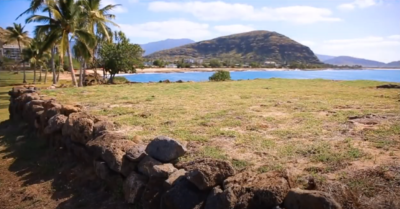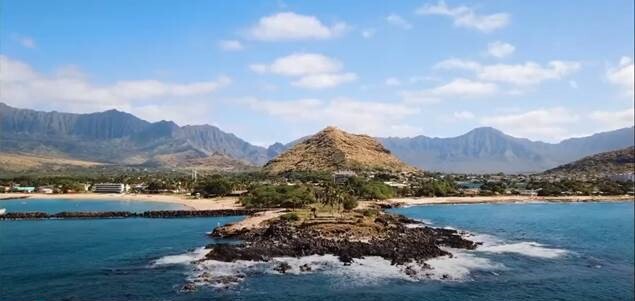Historically significant Kū‘īlioloa Heiau located in the park’s Kāne‘īlio Point
Re-published from the City and County of Honolulu Staff Reporter, Nate Serota.
 Following completion of renovations to security features and bathroom fixtures within the Pōka‘ī Bay Beach Park comfort station, the highly-utilized facility is now open to the public.
Following completion of renovations to security features and bathroom fixtures within the Pōka‘ī Bay Beach Park comfort station, the highly-utilized facility is now open to the public.
The comfort station was closed at the end of February 2023 for the initial security improvement project. Completion of this project was delayed due to supply issues, and was followed by specialized maintenance staff with the Honolulu Department of Parks and Recreation (DPR) renovating the inside of the bathrooms by: installing new fixtures, building new stall doors, masonry work to raise the height of the bathroom stalls, painting the floors, and providing the base coats for the community mural with paint donated by the Wai‘anae Moku Kūpuna Council.
Once that work was finished, community members from the Council and Pu‘u Honua O Wai‘anae began repainting the murals adorning the bathroom’s interior. On the women’s side, flowers and birds (such as the ‘iwa and ‘ua‘u) will adorn the walls, while on the men’s side Maui’s hook and various island fish will be painted. The murals are expected to be completed in early September.
In addition, in mid-August DPR began installation of signage indicating the site of the historically significant Kū‘īlioloa Heiau, located in Kāne‘īlio Point on the ‘Ewa-side of the nearly 15.5-acre beach park. The signage follows a long-standing community request and passing of Resolution 22-191, introduced by Councilmember Andria Tupola. This legislation affirms the name of the heiau, and requested the appropriate signage to indicate the cultural significance of the heiau, while encourage those visiting the site to respect the sacred location.
 Complementing this signage and heiau recognition effort, the installation of community-donated sculpture near the entrance of the heiau is expected this fall. Entitled “Nā Ho’okele (Many Navigators)” by Hanalei Kila Hopfe, the piece is described as a five-foot tall lava stone sculpture depicting a male figure wearing a malo and holding a navigational chart of the north star. The installation is pending approval of a Gift Resolution by the Honolulu City Council.
Complementing this signage and heiau recognition effort, the installation of community-donated sculpture near the entrance of the heiau is expected this fall. Entitled “Nā Ho’okele (Many Navigators)” by Hanalei Kila Hopfe, the piece is described as a five-foot tall lava stone sculpture depicting a male figure wearing a malo and holding a navigational chart of the north star. The installation is pending approval of a Gift Resolution by the Honolulu City Council.
The heiau’s name Kū‘īlioloa translates to “long dog”, in honor of the legendary kupua (demigod) who protected travelers. Serving as a important landmark for Native Hawaiian voyagers, the heiau was also used as a school to teach history, astronomy, navigation, and genealogies of ancient chiefs and kings for Wai‘anae youth. This was of particular importance following the invasion and conquering of O‘ahu by King Kamehameha. It is believed Kamehameha visited the heiau after the invasion, during which time the heiau’s current name was determined.
In recent history, the Hōkūle‘a, other Hawaiian wa‘a (canoes), and members of the voyaging community visited the heiau and beach park as an element of their educational efforts. These visits include one in March 2023, prior to the Hōkūle‘a’s Moaninuiākea voyage, and in Dec. 2017 when Mayors from all four Hawaiian counties committed to transforming the islands’ ground transportation to 100 percent renewable fuel sources by 2045.
DPR extended its appreciation for the patience and understanding of the public while special coordination was required for the completion of the comfort station renovations, heiau signage, and a future community sculpture. Proper consideration and approval were necessary for excavation work, particularly to install the signs, which required additional time and coordination to ensure the work would not negatively impact any of the cultural aspects of the heiau or the surrounding area.
 In January 2018, Historic Hawai‘i Foundation hosted a community forum on Asian American Native Hawaiian Pacific Islander Heritage. The program included a semester-long Youth Video Project, which paired youth from Wai‘anae High School’s Searider Productions program with mentors from UH West O‘ahu’s Academy of Creative Media, examining issues of culture, identity and place and resulting in 3 student produced videos. “Wai‘anae Heiau” explores Kū‘ilioloa Heiau at Kāne‘ilio Point at Pōka‘ī Bay which once served as a school of navigation and a blessing site for voyagers.
In January 2018, Historic Hawai‘i Foundation hosted a community forum on Asian American Native Hawaiian Pacific Islander Heritage. The program included a semester-long Youth Video Project, which paired youth from Wai‘anae High School’s Searider Productions program with mentors from UH West O‘ahu’s Academy of Creative Media, examining issues of culture, identity and place and resulting in 3 student produced videos. “Wai‘anae Heiau” explores Kū‘ilioloa Heiau at Kāne‘ilio Point at Pōka‘ī Bay which once served as a school of navigation and a blessing site for voyagers.


